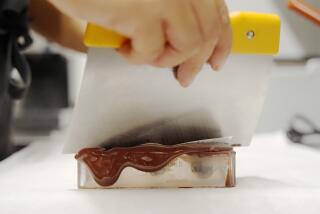Chocolate Whipped Cream Recipe
- Share via
Question: Do you have a good technique for making chocolate whipped cream? It’s delicious, but whenever I make it I am unable to get a perfectly smooth texture. I’ve used all kinds of chocolate, but I always get some small stubborn unmelted pieces after blending with the whipped cream.
Answer: Obviously, you are referring to a recipe using solid chocolate that needs to be melted as opposed to one made with cocoa powder. The first can indeed be tricky if the chocolate doesn’t remain liquid while mixing with the whipped cream. It is also more difficult to obtain a smooth blend when the cream is overwhipped rather than whipped to a soft-peak stage.
Here is a recipe from Flo Braker’s “The Simple Art of Perfect Baking” (William Morrow: $24.95). Braker writes that the temperature of the chocolate and whipped cream is important to avoid small chips of chocolate appearing.
CHOCOLATE WHIPPED CREAM
4 ounces semisweet chocolate, chopped into julienne pieces
1 cup whipping cream
Melt chocolate by placing in 1-quart mixing bowl that fits snugly over another bowl filled with hot tap water (120 degrees). When smooth and melted, remove 2 tablespoons water from bowl below and pour over melted chocolate. Whisk until smooth and glossy. Leave over water bath while whipping cream.
Pour cream into deep 1 1/2-quart mixing bowl. Whip until soft peaks form on surface but cream remains somewhat liquid underneath. (You can detect how liquid by wiggling bowl.)
When chocolate is 98.6 degrees on candy thermometer, remove from water bath. Pour in half of softly whipped cream and whisk immediately to combine. (Note that cream slightly deflates from warmth of chocolate.)
Pour all of chocolate cream into remaining whipped cream and whisk together until it is incorporated, resulting in cream with smooth soft peaks. (Too much manipulation of cream will change smooth texture.) Use immediately as frosting or filling. Makes about 2 1/2 cups.
Note: There is less problem encountered when cocoa powder is used in Chocolate Whipped Cream. To make 2 cups of this, first mix 1/2 cup sugar and 1/4 cup cocoa powder, then stir in 1 cup whipping cream. Chill at least 30 minutes to dissolve, then whip until soft peaks form.
Q: I recently bought some small green, round pears in Chinatown and I found them to be crisp and delicious. Can you tell me more about this fruit? Someone said they are also called Japanese pears.
A: You are referring to the apple pear, which is known by a variety of names. Besides Japanese pear, it also is called Asian pear, Oriental pear, pear-apple, Chalea (in British Columbia), shalea, sha li (Chinese for sand pear because it is slightly gritty) and yashi (Japanese). Originally introduced to this country by Chinese gold miners in the California gold rush days, the apple pear is not a cross between an apple and a pear, even though at its ripe stage, the fruit remains crisp like an apple. Most of these pears have a slight russeting on the skin and appear somewhat like an anjou or comice pear.
Q: Years ago, I called a number that answered questions on safety of meat and poultry. Unfortunately, I lost the number and I’m not even certain if it is still in operation. Can you please give me the number?
A: The U.S. Department of Agriculture has a Meat and Poultry Hotline that answers questions on safety, wholesomeness or labeling of meat and poultry products. They recently changed the hot line to a toll-free number: (800) 535-4555.
Q: I have two guava bushes, one a strawberry guava, and the other a pineapple guava. Besides eating them out of hand and making jelly (which I don’t since my husband is diabetic), are there other ways to use the fruit? I freeze fruit and vegetables and tried to freeze the guavas by peeling them and stewing them slightly but the taste wasn’t great. Any suggestions will be tried and appreciated.
A: One reader also inquired why there are no guavas on the produce shelf. Since the fruit is highly perishable and begins deteriorating within one to two days, there is no retail market for it. All of the recipes that I have seen for guavas are on the sweet side since guavas have an acid-sweet taste.
Aside from jellies, jams and spreads, the fruit is generally turned into a puree, nectar or concentrate with sugar added, then is used in cakes, quick breads, sweet meat sauces or glazes, punches, gelatin molds, pies and sherbets, pies, mousses and other desserts.
Guavas should be frozen with syrup. Select ripe and tender fruit. Wash, peel and cut in halves. Using a syrup base of one to two cups sugar to four cups water, cook guavas until just tender in the syrup. Cool. Pack and cover with cold syrup. Seal and freeze.
Address questions on food preparation to You Asked About, Food Section, The Times, Times Mirror Square, Los Angeles 90053. Personal replies cannot be given.
More to Read
Eat your way across L.A.
Get our weekly Tasting Notes newsletter for reviews, news and more.
You may occasionally receive promotional content from the Los Angeles Times.








